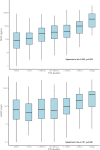Association of day-of-injury plasma glial fibrillary acidic protein concentration and six-month posttraumatic stress disorder in patients with mild traumatic brain injury
- PMID: 35717463
- PMCID: PMC9630517
- DOI: 10.1038/s41386-022-01359-5
Association of day-of-injury plasma glial fibrillary acidic protein concentration and six-month posttraumatic stress disorder in patients with mild traumatic brain injury
Erratum in
-
Correction to: Association of day-of-injury plasma glial fibrillary acidic protein concentration and six-month posttraumatic stress disorder in patients with mild traumatic brain injury.Neuropsychopharmacology. 2022 Dec;47(13):2332. doi: 10.1038/s41386-022-01466-3. Neuropsychopharmacology. 2022. PMID: 36180785 Free PMC article. No abstract available.
Abstract
Several proteins have proven useful as blood-based biomarkers to assist in evaluation and management of traumatic brain injury (TBI). The objective of this study was to determine whether two day-of-injury blood-based biomarkers are predictive of posttraumatic stress disorder (PTSD). We used data from 1143 individuals with mild TBI (mTBI; defined as admission Glasgow Coma Scale [GCS] score 13-15) enrolled in TRACK-TBI, a prospective longitudinal study of level 1 trauma center patients. Plasma glial fibrillary acidic protein (GFAP) and serum high sensitivity C-reactive protein (hsCRP) were measured from blood collected within 24 h of injury. Two hundred and twenty-seven (19.9% of) patients had probable PTSD (PCL-5 score ≥ 33) at 6 months post-injury. GFAP levels were positively associated (Spearman's rho = 0.35, p < 0.001) with duration of posttraumatic amnesia (PTA). There was an inverse association between PTSD and (log)GFAP (adjusted OR = 0.85, 95% CI 0.77-0.95 per log unit increase) levels, but no significant association with (log)hsCRP (adjusted OR = 1.11, 95% CI 0.98-1.25 per log unit increase) levels. Elevated day-of-injury plasma GFAP, a biomarker of glial reactivity, is associated with reduced risk of PTSD after mTBI. This finding merits replication and additional studies to determine a possible neurocognitive basis for this relationship.
© 2022. The Author(s).
Conflict of interest statement
The authors declare no competing interests.
Figures


References
-
- Nelson LD, Temkin NR, Dikmen S, Barber J, Giacino JT, Yuh E, et al. Recovery after mild traumatic brain injury in patients presenting to US Level I trauma centers: A transforming research and clinical knowledge in Traumatic Brain Injury (TRACK-TBI) Study. JAMA Neurol. 2019;76:1049–59. - PMC - PubMed
-
- Albrecht JS, Abariga SA, Rao V, Wickwire EM. Incidence of new neuropsychiatric disorder diagnoses following traumatic brain injury. J Head Trauma Rehabil. 2020;35:E352–E360. - PubMed
Publication types
MeSH terms
Substances
Grants and funding
LinkOut - more resources
Full Text Sources
Other Literature Sources
Medical
Research Materials
Miscellaneous

